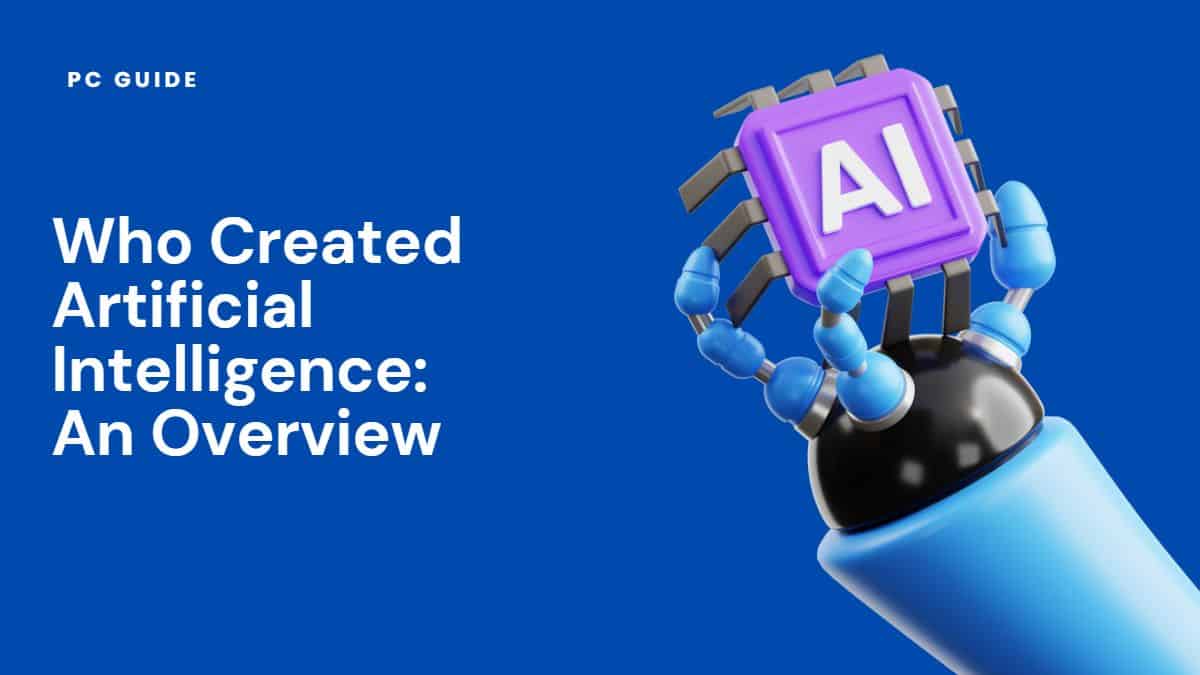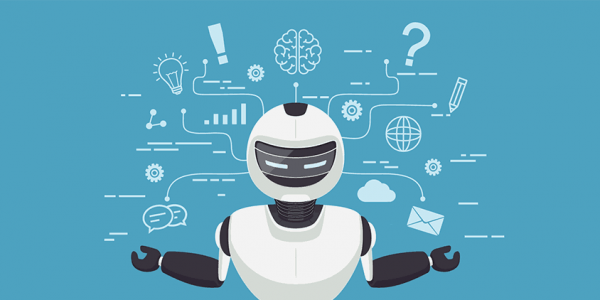Who Created Artificial Intelligence – An Overview

Table of Contents
AI has made our life more straightforward, from speech recognition to streaming platforms and self-driving cars. But have you ever wondered who created artificial intelligence and how it began? If yes, then this read has all your answers.
Artificial Intelligence: Towards An Intelligent World

Artificial Intelligence (AI) is the ability of machines to perform tasks based on the information fed into their system. It uses data to respond to a particular command and mimics human behavior based on its learnings.
Prime Day may have closed its doors, but that hasn't stopped great deals from landing on the web's biggest online retailer. Here are all the best last chance savings from this year's Prime event.
- Sapphire 11348-03-20G Pulse AMD Radeon™ RX 9070 XT Was $779 Now $719
- AMD Ryzen 7 7800X3D 8-Core, 16-Thread Desktop Processor Was $449 Now $341
- Skytech King 95 Gaming PC Desktop, Ryzen 7 9800X3D 4.7 GHz Was $2,899 Now $2,599
- LG 77-Inch Class OLED evo AI 4K C5 Series Smart TV Was $3,696 Now $2,996
- AOC Laptop Computer 16GB RAM 512GB SSD Was $360.99 Now $306.84
- Lexar 2TB NM1090 w/HeatSink SSD PCIe Gen5x4 NVMe M.2 Was $281.97 Now $214.98
- Apple Watch Series 10 GPS + Cellular 42mm case Smartwatch Was $499.99 Now $379.99
- AMD Ryzen 9 5950X 16-core, 32-thread unlocked desktop processor Was $3199.99 Now $279.99
- Garmin vívoactive 5, Health and Fitness GPS Smartwatch Was $299.99 Now $190
*Prices and savings subject to change. Click through to get the current prices.
Who are the Pioneers of Artificial Intelligence?
When we elaborate on the creators of artificial intelligence, two names stand out: John McCarthy and Marvin Minsky. John McCarthy, often referred to as the “father of AI,” coined the term “artificial intelligence” in 1956. He dedicated his life to AI research, focusing on problem-solving and logical reasoning in AI systems.
Marvin Minsky, another pioneer in the field, co-founded the Massachusetts Institute of Technology’s Media Lab and made significant contributions to the development of AI. He developed theories on how to create AI systems that could mimic human intelligence, laying the groundwork for future advancements in AI.
History of Artificial Intelligence
The idea of AI had become ingrained in the minds of scientists, mathematicians, and philosophers by the 1950s. It was Alan Turing, a British polymath, who created artificial intelligence. He investigated the mathematical potential of AI. He questioned that if people use accessible knowledge to solve issues and make decisions, why shouldn’t machines be able to do the same? His 1950 study, Computing Machinery and Intelligence, examined how to create intelligent machines and how to assess their intelligence.
What is the Turing Test, and Why is it Important in AI?
The Turing Test, proposed by British mathematician Alan Turing, is a method for determining whether an AI system can exhibit intelligent behavior equivalent to, or indistinguishable from, that of a human.
The test plays a crucial role in measuring an AI system’s capabilities and accuracy. It serves as a benchmark for AI development, pushing researchers to create AI systems that can pass the test and exhibit human-like intelligence.
How Did Computer Science Contribute to the Creation of AI?
Computer science has been instrumental in the creation of artificial intelligence. The development of the first computer laid the groundwork for AI, providing a platform where machine learning algorithms could be tested and refined.
These algorithms, which are a core component of AI, allow machines to learn from data and make decisions or predictions. The field of computer science has provided the tools and techniques necessary for developing these complex algorithms, making it a crucial contributor to the creation of AI.
The AI Timeline
There have been numerous advancements in this field after Turing's initiative.
- The 1950s: Allen Newell, Cliff Shaw, and Herbert Simon produced Logic Theorist, regarded as the first AI program. It is capable of solving mathematical theorems.
- The 1960s and 1970s: Funding for AI grew, thanks in part to DARPA‘s assistance from the government.
- The 1980s: Deep learning and expert systems enabled computers to learn from experience and replicate the human decision-making process, respectively.
- In the 2000s: AI-powered products like IBM's Deep Blue, Furby Toys, and Apple's Siri gained popularity.
Today, developers are releasing new AI programs such as chatbots, virtual assistants, autonomous vehicles, and machine learning tools.
Who is Joseph Weizenbaum, and What is ELIZA?
Joseph Weizenbaum was a German-American computer scientist known for his work in AI. He created ELIZA, one of the earliest examples of natural language processing in AI.
ELIZA was designed to mimic human conversation, demonstrating the potential of AI in understanding and interacting with human language. Weizenbaum’s work laid the foundation for future advancements in NLP, a crucial aspect of AI development.
What Was the Fifth Generation Computer Project?
The Fifth Generation Computer Project was an initiative by Japan’s Ministry of International Trade and Industry, begun in 1982, to create a “fifth-generation” computer which was supposed to perform much calculation utilizing massive parallelism. It was intended to push the boundaries of computer technology, and it played a significant role in advancing AI development.
The project aimed to develop computers that could carry out high-level decision-making tasks, similar to humans. While the project faced many challenges, it contributed to the development of logic programming and other AI-related technologies.
Who is Garry Kasparov, and What is His Connection to AI?
Garry Kasparov is a world chess champion known for his encounter with AI. In 1997, he played a chess match against IBM’s Deep Blue, an AI program.
This was a landmark event in the history of AI, as it was one of the first times an AI system had competed against a world champion in any field. Although Kasparov lost the match, the event demonstrated the potential of AI and its ability to challenge human intelligence.
What Role Did Chess Play in the Development of AI?
Chess has played a significant role in the development of AI. In the early days of AI research, chess was used as a platform to test and develop AI algorithms. The game’s complexity and the need for strategic thinking made it an ideal testing ground for AI capabilities.
Researchers used chess to develop AI systems capable of problem-solving and decision-making, key aspects of human intelligence.
How Has AI Evolved?
AI has evolved significantly over time, from weak AI systems that can only perform specific tasks, to strong AI systems that can perform any intellectual task that a human being can do.
Today, we have narrow AI, which is designed to perform a narrow task (such as facial recognition or internet searches), and artificial neural networks, which mimic the human brain’s operations to ‘learn’ from data. This evolution has been driven by advancements in technology and a more profound understanding of human intelligence.
AI Is the future!

From the man who created artificial intelligence to the new-age AI-powered platforms, the journey has been exciting. Today, innovations are making us eagerly wait to see what the future holds.
How Does AI Mimic Human Brains?
AI systems mimic human brains using a structure called a neural network. These networks are composed of interconnected layers of nodes, or “neurons,” which process information in a way that mimics how neurons in the human brain work. This structure allows AI systems to learn from experience, recognize patterns, and make decisions, much like human brains.
How Has Google Contributed to AI Development?
Google has been at the forefront of AI development, making significant contributions to the field. The tech giant has made advancements in neural networks, a type of AI that mimics the human brain’s structure. Google has also made strides in natural language processing (NLP), a branch of AI that focuses on the interaction between computers and human language. Through its research and development, Google continues to push the boundaries of what AI can do.
How Has AI Been Portrayed in Science Fiction?
AI and robots have been a staple of science fiction for decades. These portrayals often explore the potential of AI, its ethical implications, and its impact on society. While these depictions can be exaggerated, they reflect real-world AI research and development to some extent. They also influence public perception of AI, shaping our expectations and understanding of this technology.
FAQs
Will AI Rob Us of Our Jobs?
No, AI won’t steal your job. Instead, it will make human jobs less complicated and enable you to be in control while working with AI-powered machines.
Will AI Rule the World?
Even if it seems plausible in a work of fiction, it is not feasible in the real world. AI-powered devices are still subject to human oversight, while also being restricted to the duties they have been taught.
What is LISP, and How Did It Contribute to AI Development?
LISP is a high-level programming language, developed by John McCarthy, one of the pioneers of AI.
LISP stands for “LISt Processing,” and it was designed for easy manipulation of data strings. Used extensively in AI research, LISP made it easier for researchers to develop and test AI algorithms. Its flexibility and expressiveness made it a popular choice for AI development during the early years of AI research.
What Role Do Data Sets Play in AI?
Data sets play a crucial role in AI. They are used to training machine learning algorithms, allowing AI systems to learn and improve. By processing large data sets, AI systems can identify patterns, learn from them, and make predictions or decisions based on this learned information. The quality and diversity of the data sets used can significantly impact the performance of an AI system.
How Accurate Are AI Predictions?
The accuracy of AI predictions can vary widely and depends on several factors, including the quality of the data used for training and the complexity of the algorithm. However, AI has made some remarkably accurate predictions in various fields.
For instance, AI has been used to predict stock market trends, weather patterns, and even the outcome of sports games. In the realm of science fiction, AI systems like HAL 9000 from “Space Odyssey” and real-world applications like Alexa and ChatGPT have demonstrated the potential of AI in making accurate predictions.
Takeaway
To wrap things up, the birth of artificial intelligence serves as a shining beacon of human ingenuity and our unyielding quest for knowledge.
The remarkable collaboration and tireless dedication of visionaries like John McCarthy and Marvin Minsky, coupled with the groundbreaking strides made by esteemed organizations such as Google, have fueled the evolution of AI across the decades. Whether we marvel at the intricate strategies of chess or delve into the complexities of machine learning algorithms, each facet of AI represents a vital piece in an intricate mosaic.
As we continue our journey into this captivating realm, we eagerly anticipate the forthcoming discoveries and groundbreaking innovations that will undoubtedly deepen our understanding of AI’s full potential and its boundless capacity to revolutionize our very existence.
